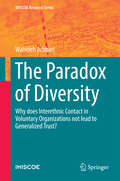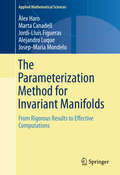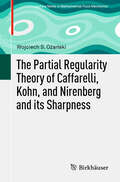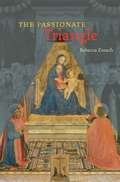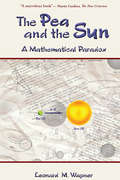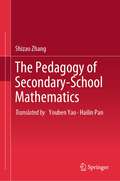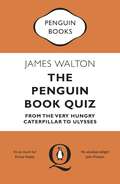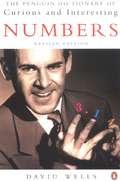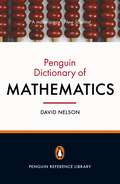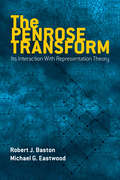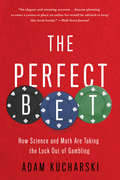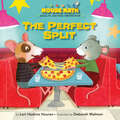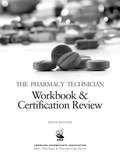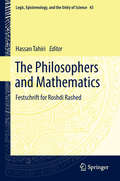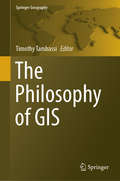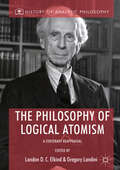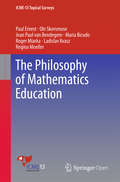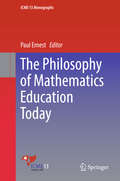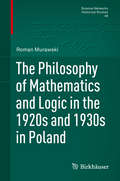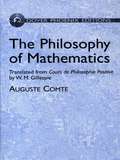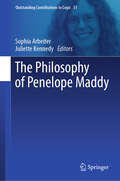- Table View
- List View
The Paradox of Diversity
by Wahideh AchbariThis book is about ethnic diversity in voluntary organizations and seeks to explain whether intergroup contact contributes to the development of generalized trust. It relies on a novel multilevel design and data from Amsterdam in which 40 voluntary organizations and 463 participants have been sampled. Contrary to conventional wisdom, this book argues that cognitive processes are contributing more toward the evaluation of strangers or generalized trust than interethnic contact. Since trusting unknown people is essentially a risky endeavor, this suggests that participants of both association types who report trusting strangers can afford to do so, because they are better educated, have a more positive worldview, and have had fewer negative life experiences. That is to say, they are socially more successful and view their future as more promising. Previous findings are inconclusive since most studies that conclude diversity has led to less generalized trust do not include interethnic contact directly in their analyses. These studies also downplay the importance of cognitive processes, which may shape generalized trust. What is more, people join ethnically diverse civic groups, because they already have more trustful attitudes, rather than learning to trust through interethnic contact. Despite the recent multiculturalist backlash, this book demonstrates that participation in ethno-national organizations does not pose a threat to social cohesion. The analysis in this book serves to build a general theory of trust that moves beyond emphasizing interaction between people who are different from each other, but one that includes the importance of cognition.
The Parameterization Method for Invariant Manifolds
by Àlex Haro Marta Canadell Jordi-Lluis Figueras Alejandro Luque Josep Maria MondeloThismonograph presents some theoretical and computational aspects of theparameterization method for invariant manifolds, focusing on the followingcontexts: invariant manifolds associated with fixed points, invariant tori inquasi-periodically forced systems, invariant tori in Hamiltonian systems andnormally hyperbolic invariant manifolds. This book provides algorithms ofcomputation and some practical details of their implementation. The methodologyis illustrated with 12 detailed examples, many of them well known in theliterature of numerical computation in dynamical systems. A public version of the software used for some of the examples is available online. Thebook is aimed at mathematicians, scientists and engineers interested in thetheory and applications of computational dynamical systems.
The Partial Regularity Theory of Caffarelli, Kohn, and Nirenberg and its Sharpness (Advances in Mathematical Fluid Mechanics)
by Wojciech S. OżańskiThis monograph focuses on the partial regularity theorem, as developed by Caffarelli, Kohn, and Nirenberg (CKN), and offers a proof of the upper bound on the Hausdorff dimension of the singular set of weak solutions of the Navier-Stokes inequality, while also providing a clear and insightful presentation of Scheffer’s constructions showing their bound cannot be improved. A short, complete, and self-contained proof of CKN is presented in the second chapter, allowing the remainder of the book to be fully dedicated to a topic of central importance: the sharpness result of Scheffer. Chapters three and four contain a highly readable proof of this result, featuring new improvements as well. Researchers in mathematical fluid mechanics, as well as those working in partial differential equations more generally, will find this monograph invaluable.
The Passionate Triangle
by Rebecca ZorachTriangles abounded in the intellectual culture of early modern Europe—the Christian Trinity was often mapped as a triangle, for instance, and perspective, a characteristic artistic technique, is based on a triangular theory of vision. Renaissance artists, for their part, often used shapes and lines to arrange figures into a triangle on the surface of a painting—a practice modern scholars call triangular composition. But is there secret meaning in the triangular arrangements artists used, or just a pleasing symmetry? What do triangles really tell us about the European Renaissance and its most beguiling works of art? In this book, Rebecca Zorach takes us on a lively hunt for the triangle’s embedded significance. From the leisure pursuits of Egyptian priests to Jacopo Tintoretto’s love triangles, Zorach explores how the visual and mathematical properties of triangles allowed them to express new ideas and to inspire surprisingly intense passions. Examining prints and paintings as well as literary, scientific, and philosophical texts, The Passionate Triangle opens up an array of new ideas, presenting unexpected stories of the irrational, passionate, melancholic, and often erotic potential of mathematical thinking before the Scientific Revolution.
The Pea and the Sun: A Mathematical Paradox
by Leonard M. WapnerTake an apple and cut it into five pieces. Would you believe that these five pieces can be reassembled in such a fashion so as to create two apples equal in shape and size to the original? Would you believe that you could make something as large as the sun by breaking a pea into a finite number of pieces and putting it back together again? Neither did Leonard Wapner, author of The Pea and the Sun, when he was first introduced to the Banach-Tarski paradox, which asserts exactly such a notion. Written in an engaging style, The Pea and the Sun catalogues the people, events, and mathematics that contributed to the discovery of Banach and Tarski's magical paradox. Wapner makes one of the most interesting problems of advanced mathematics accessible to the non-mathematician.
The Pedagogy of Secondary-School Mathematics
by Shizao ZhangThis book elucidates the principal aspects and characteristics of secondary school mathematics teaching and learning in China. It combines the cultivation of students' mathematical abilities with the improvement of teaching skills, and explores from both theory and practice to create mathematical pedagogy which has been widely recognized by experts in this field. This book presents a number of mathematics teaching principles and methods, and has been used as an important resource book for mathematics teachers’ education.
The Penguin Book Quiz: From The Very Hungry Caterpillar to Ulysses – The Perfect Gift!
by James WaltonTHE PERFECT QUIZ BOOK FOR BOOKWORMS!Which Haruki Murakami novel shares its title with a Beatles song? In Roald Dahl's Charlie and the Chocolate Factory, what is Charlie's surname? What is heavy-drinking Rachel Watson known as in the title of a 21st-century bestseller? And what do you get if you add the number of Bennet sisters in Jane Austen's Pride and Prejudice to the number of Karamazov brothers in Fyodor Dostoevsky's The Brothers Karamazov?With four hundred questions covering books from literary classics to modern bestsellers, through iconic children's books and books you say that you've read but really you haven't, The Penguin Book Quiz is as appropriate for a making you look well-read at a party as it is for a book-loving family to tuck into after Christmas dinner: it's as enjoyable to read as it is to play.Featuring the work of everyone from Antony Beevor to Zadie Smith, books from The Very Hungry Caterpillar to Ulysses, and with movie, music, television and literary references abound, this entertaining quiz tickles the fancy (and the brains) of light and heavy readers alike.Answers:- Norwegian Wood- Bucket- The Girl on the Train- Eight (five sisters, three brothers)
The Penguin Dictionary of Curious and Interesting Numbers
by David WellsWhy was the number of Hardy's taxi significant? Why does Graham's number need its own notation? How many grains of sand would fill the universe? What is the connection between the Golden Ratio and sunflowers? Why is 999 more than a distress call? All these questions and a host more are answered in this fascinating book, which has now been newly revised, with nearly 200 extra entries and some 250 additions to the original entries. From minus one and its square root, via cyclic, weird, amicable, perfect, untouchable and lucky numbers, aliquot sequences, the Cattle problem, Pascal's triangle and the Syracuse algorithm, music, magic and maps, pancakes, polyhedra and palindromes, to numbers so large that they boggle the imagination, all you ever wanted to know about numbers is here. There is even a comprehensive index for those annoying occasions when you remember the name but can't recall the number.
The Penguin Dictionary of Mathematics: Fourth edition
by Dr David NelsonThe Penguin Dictionary of Mathematics takes in all branches of pure and applied mathematics, from algebra to mechanics and from number theory to statistics. Invaluable for students at all levels, it is also a useful and versatile source book for economists, business people, engineers, technicians and scientists of all kinds who use mathematics in the course of their work.
The Penrose Transform: Its Interaction with Representation Theory
by Michael G. Eastwood Robert J. Baston"Brings to the reader a huge amount of information, well organized and condensed into less than two hundred pages." -- Mathematical ReviewsIn recent decades twistor theory has become an important focus for students of mathematical physics. Central to twistor theory is the geometrical transform known as the Penrose transform, named for its groundbreaking developer. Geared toward students of physics and mathematics, this advanced text explores the Penrose transform and presupposes no background in twistor theory and a minimal familiarity with representation theory. An introductory chapter sketches the development of the Penrose transform, followed by reviews of Lie algebras and flag manifolds, representation theory and homogeneous vector bundles, and the Weyl group and the Bott-Borel-Weil theorem. Succeeding chapters explore the Penrose transform in terms of the Bernstein-Gelfand-Gelfand resolution, followed by worked examples, constructions of unitary representations, and module structures on cohomology. The treatment concludes with a review of constructions and suggests further avenues for research.
The Perfect Bet: How Science and Math Are Taking the Luck Out of Gambling
by Adam KucharskiThere is one thing about gambling that everyone knows: the house always wins. Lotteries are set up to guarantee profits, to the state. A craps game is a sure thing, but only if you own the table. Sometimes, however, everyone is wrong. After all, the reason that casinos ban card counters is that counting cards works. Indeed, for the past 500 years, gamblers-led by mathematicians and scientists-have been trying to figure out how to turn the tables on the house and pull the rug out from under Lady Luck. In The Perfect Bet, mathematician and award-winning writer Adam Kucharski tells the astonishing story of how the experts have done it, revolutionizing mathematics and science in the process. From Galileo to Alan Turing, betting has been scientists' playground for ideas: dice games in sixteenth-century bars gave birth to the theory of probability, and poker to game theory (mathematician John von Neumann wanted to improve his game) and to much of artificial intelligence. Kucharski gives us a collection of rogues, geniuses, and mavericks who are equally at home in a casino in Monte Carlo as investigating how to build an atomic bomb for the Manhattan Project. They include the mathematician who flipped a coin 25,000 times to see if it was fair; the college kids who gamed the Massachusetts lottery to yield millions of dollars in profit; and the horse-betting syndicates of Hong Kong's Happy Valley, who turned a wager on ponies into a multi-billion-dollar industry. With mathematical rigor and narrative flair, Adam Kucharski reveals the tangled history of betting and science. The house can seem unbeatable. In this book, Kucharski shows us just why it isn't. Even better, he shows us how the search for the perfect bet has been crucial for the scientific pursuit of a better world
The Perfect Split (Mouse Math)
by Lori Haskins HouranEach read-aloud book in the Mouse Math series focuses on a single, basic math concept and features adorable mice, Albert and Wanda, who live in a People House. Entertaining fiction stories capture kids&’ imaginations as the mice learn about numbers, shapes, sizes and more. Over 3 million copies sold worldwide!Melty's has games! Pizza! Prizes! Albert and Leo promise to split everything evenly, from the food to the tickets to the prizes. But some things just can't be split. When it comes to one special prize--winner takes all! Every Mouse Math title includes back matter activities that support and extend reading comprehension and math skills, plus free online activities. (Math concept: Equal to, less than, greater than).
The Pharmacy Technician Workbook and Certification Review (Basic Pharmacy and Pharmacology)
by American Pharmacy AssociationThis workbook was developed to correspond with the textbook, The Pharmacy Technician, Sixth Edition, by Perspective Press. For pharmacy technician students, it is a valuable tool for success. It provides a useful format for memorizing important information and checking knowledge. Hundreds of key concepts and terms are carefully explained, and there are over 1,000 exercises and problems for self testing. Answers are included at the back of the book "In the Workplace" sections provide sample job-related documents and skills checklists. The sixth edition includes additional skills checklists as well as "In the Workplace Activities" that provide practical, active-learning applications of the concepts discussed in The Pharmacy Technician. Working out these exercises and activities successfully will help you to succeed in your training.
The Philosophers and Mathematics: Festschrift for Roshdi Rashed (Logic, Epistemology, and the Unity of Science #43)
by Hassan TahiriThis book explores the unique relationship between two different approaches to understand the nature of knowledge, reality, and existence. It collects essays that examine the distinctive historical relationship between mathematics and philosophy. Readers learn what key philosophers throughout the ages thought about mathematics. This includes both thinkers who recognized the relevance of mathematics to their own work as well as those who chose to completely ignore its many achievements.The essays offer insight into the role that mathematics played in the formation of each included philosopher’s doctrine as well as the impact its remarkable expansion had on the philosophical systems each erected. Conversely, the authors also highlight the ways that philosophy contributed to the growth and transformation of mathematics. Throughout, significant historical examples help to illustrate these points in a vivid way. Mathematics has often been a favored interlocutor of philosophers and a major source of inspiration. This book is the outcome of an international conference held in honor of Roshdi Rashed, a renowned historian of mathematics. It provides researchers, students, and interested readers with remarkable insights into the history of an important relationship throughout the ages.
The Philosophy of GIS (Springer Geography)
by Timothy TambassiThis anthology aims to present the fundamental philosophical issues and tools required by the reflection within and upon geography and Geographic Information Systems (GIS) . It is an introduction to the philosophy for GIScience from an analytical perspective, which looks at GIS with a specific focus on its fundamental and most general concepts and distinctions. The first part of the book is devoted to explore some of the main philosophical questions arising from GIS and GIScience, which include, among others, investigations in ontology, epistemology, linguistics and geometrical modeling. The second part concerns issues related to spatial and cartographical representations of the geographical world. The third part is focused on the ontology of geography, specifically in terms of geographical entities, objects and boundaries. Finally, in the fourth part, the topic of GIS constitutes a starting point for exploring themes such as quantum geography and disorientation, and for defining professional profiles for geographers with competences in GIS environment. This book on a new and unexplored field of research could be a fundamental point of reference for professional philosophers and geographers interested in the theoretical reflection about the foundational concepts of GIScience. It is also interesting reading material for students (both undergraduates, postgraduates and Ph.D. students) in philosophy, geography, applied ontology, GIScience, geomatics and computer science.
The Philosophy of Logical Atomism: A Centenary Reappraisal (History of Analytic Philosophy)
by Gregory Landini Landon D. ElkindThis book offers a comprehensive critical survey of issues of historical interpretation and evaluation in Bertrand Russell's 1918 logical atomism lectures and logical atomism itself. These lectures record the culmination of Russell's thought in response to discussions with Wittgenstein on the nature of judgement and philosophy of logic and with Moore and other philosophical realists about epistemology and ontological atomism, and to Whitehead and Russell’s novel extension of revolutionary nineteenth-century work in mathematics and logic. Russell's logical atomism lectures have had a lasting impact on analytic philosophy and on Russell's contemporaries including Carnap, Ramsey, Stebbing, and Wittgenstein. Comprised of 14 original essays, this book will demonstrate how the direct and indirect influence of these lectures thus runs deep and wide.
The Philosophy of Mathematics Education
by Paul Ernest Ole Skovsmose Jean Paul van Bendegem Maria Bicudo Roger Miarka Ladislav Kvasz Regina MoellerAlthough many agree that all teaching rests on a theory of knowledge, there has been no in-depth exploration of the implications of the philosophy of mathematics for education. This is Paul Ernest's aim. Building on the work of Lakatos and Wittgenstein it challenges the prevalent notion that mathematical knowledge is certain, absolute and neutral, and offers instead an account of mathematics as a social construction. This has profound educational implications for social issues, including gender, race and multiculturalism; for pedagogy, including investigations and problem solving; and challenges hierarchical views of mathematics, learning and ability. Beyond this, the book offers a well-grounded model of five educational ideologies, each with its own epistemology, values, aims and social group of adherents. An analysis of the impact of these groups on the National Curriculum results in a powerful critique, revealing the questionable assumptions, values and interests upon which it rests. The book finishes on an optimistic note, arguing that pedagogy, left unspecified by the National Curriculum, is the way to achieve the radical aims of educating confident problem posers and solvers who are able to critically evaluate the social uses of mathematics.
The Philosophy of Mathematics Education Today (ICME-13 Monographs)
by Paul ErnestThis book offers an up-to-date overview of the research on philosophy of mathematics education, one of the most important and relevant areas of theory. The contributions analyse, question, challenge, and critique the claims of mathematics education practice, policy, theory and research, offering ways forward for new and better solutions. The book poses basic questions, including: What are our aims of teaching and learning mathematics? What is mathematics anyway? How is mathematics related to society in the 21st century? How do students learn mathematics? What have we learnt about mathematics teaching? Applied philosophy can help to answer these and other fundamental questions, and only through an in-depth analysis can the practice of the teaching and learning of mathematics be improved. The book addresses important themes, such as critical mathematics education, the traditional role of mathematics in schools during the current unprecedented political, social, and environmental crises, and the way in which the teaching and learning of mathematics can better serve social justice and make the world a better place for the future.
The Philosophy of Mathematics and Logic in the 1920s and 1930s in Poland
by Roman MurawskiThe aim of this book is to present and analyze philosophical conceptions concerning mathematics and logic as formulated by Polish logicians, mathematicians and philosophers in the 1920s and 1930s. It was a remarkable period in the history of Polish science, in particular in the history of Polish logic and mathematics. Therefore, it is justified to ask whether and to what extent the development of logic and mathematics was accompanied by a philosophical reflection. We try to answer those questions by analyzing both works of Polish logicians and mathematicians who have a philosophical temperament as well as their research practice. Works and philosophical views of the following Polish scientists will be analyzed: WacÅ,aw SierpiÅ,,ski, Zygmunt Janiszewski, Stefan Mazurkiewicz, Stefan Banach Hugo Steinhaus, Eustachy Å»yliÅ,,sk and Leon Chwistek, Jan Å ukasiewicz, Zygmunt Zawirski, StanisÅ,aw LeÅ>niewski, Tadeusz KotarbiÅ,,ski, Kazimierz Ajdukiewicz, Alfred Tarski, Andrzej Mostowski and Henryk Mehlberg, Jan SleszyÅ,,ski, StanisÅ,aw Zaremba and Witold Wilkosz. To indicate the background of scientists being active in the 1920s and 1930s we consider in Chapter 1 some predecessors, in particular: Jan Åsniadecki, Józef Maria Hoene-WroÅ,,ski, Samuel Dickstein and Edward Stamm.
The Philosophy of Mathematics: Translated from Cours de Philosophie Positive by W. M. Gillespie
by Auguste ComteWritten by the nineteenth-century French philosophical founder of positivism, this comprehensive map of mathematical science assigns to each part of the complex whole its true position and value. The two-part treatment begins with a general view of mathematical analysis and advances to algebra, continuing with an exploration of geometry's ancient and modern methods.
The Philosophy of Penelope Maddy (Outstanding Contributions to Logic #31)
by Juliette Kennedy Sophia ArbeiterThis volume features more than 20 essays that explore the work of one of the most important contemporary philosophers of mathematics. It will help readers to better appreciate this significant and prolific philosopher. Within philosophy of mathematics, Penelope Maddy initially advocated realism. She then went on to advance naturalism. Both of her positions became very influential in the field, along with her other work in the philosophy of logic. The contributors comment on and otherwise engage with Maddy’s work. They also weigh in on the state of set theory and its philosophy, the philosophy and history of logic, naturalism, skepticism, and the myriad other areas to which Maddy left her mark. Overall, coverage traces her influence on these various ideas over the years. It will also help readers to better understand how philosophers working at the forefront of these areas see these concepts today. These essays will be essential reading for the wide group of philosophers working in these different areas as well as graduate students studying philosophy of mathematics and logic and the other related issues to which Maddy has contributed. The volume will also appeal to logicians and set theorists in general, as well as to philosophers working in analytic philosophy more widely, as well as to those working in the history of philosophy.
The Philosophy of Set Theory: An Historical Introduction to Cantor's Paradise
by Mary TilesA century ago, Georg Cantor demonstrated the possibility of a series of transfinite infinite numbers. His methods, unorthodox for the time, enabled him to derive theorems that established a mathematical reality for a hierarchy of infinities. Cantor's innovation was opposed, and ignored, by the establishment; years later, the value of his work was recognized and appreciated as a landmark in mathematical thought, forming the beginning of set theory and the foundation for most of contemporary mathematics. As Cantor's sometime collaborator, David Hilbert, remarked, "No one will drive us from the paradise that Cantor has created." This volume offers a guided tour of modern mathematics' Garden of Eden, beginning with perspectives on the finite universe and classes and Aristotelian logic. Author Mary Tiles further examines permutations, combinations, and infinite cardinalities; numbering the continuum; Cantor's transfinite paradise; axiomatic set theory; logical objects and logical types; and independence results and the universe of sets. She concludes with views of the constructs and reality of mathematical structure. Philosophers with only a basic grounding in mathematics, as well as mathematicians who have taken only an introductory course in philosophy, will find an abundance of intriguing topics in this text, which is appropriate for undergraduate-and graduate-level courses.
The Physical and Mathematical Foundations of the Theory of Relativity: A Critical Analysis
by Antonio Romano Mario Mango FurnariThis unique textbook offers a mathematically rigorous presentation of the theory of relativity, emphasizing the need for a critical analysis of the foundations of general relativity in order to best study the theory and its implications. The transitions from classical mechanics to special relativity and then to general relativity are explored in detail as well, helping readers to gain a more profound and nuanced understanding of the theory as a whole. After reviewing the fundamentals of differential geometry and classical mechanics, the text introduces special relativity, first using the physical approach proposed by Einstein and then via Minkowski’s mathematical model. The authors then address the relativistic thermodynamics of continua and electromagnetic fields in matter – topics which are normally covered only very briefly in other treatments – in the next two chapters. The text then turns to a discussion of general relativity by means of the authors’ unique critical approach, underlining the difficulty of recognizing the physical meaning of some statements, such as the physical meaning of coordinates and the derivation of physical quantities from those of space-time. Chapters in this section cover the model of space-time proposed by Schwarzschild; black holes; the Friedman equations and the different cosmological models they describe; and the Fermi-Walker derivative. Well-suited for graduate students in physics and mathematics who have a strong foundation in real analysis, classical mechanics, and general physics, this textbook is appropriate for a variety of graduate-level courses that cover topics in relativity. Additionally, it will interest physicists and other researchers who wish to further study the subtleties of these theories and understand the contemporary scholarly discussions surrounding them.
The Physicists: The History of a Scientific Community in Modern America
by Daniel J. KevlesThis magnificent account of the coming of age of physics in America has been heralded as the best introduction to the history of science in the United States. Unsurpassed in its breadth and literary style, Kevles's account portrays the brilliant scientists who became a powerful force in bringing the world into a revolutionary new era. The book ranges widely as it links these exciting developments to the social, cultural, and political changes that occurred from the post-Civil War years to the present. Throughout, Kevles keeps his eye on the central question of how an avowedly elitist enterprise grew and prospered in a democratic culture. In this new edition, the author has brought the story up to date by providing an extensive, authoritative, and colorful account of the Superconducting Super Collider, from its origins in the international competition and intellectual needs of high-energy particle physics, through its establishment as a multibillion-dollar project, to its termination, in 1993, as a result of angry opposition within the American physics community and the Congress.
The Physics Behind... (The Behind... series)
by Russ SwanCan you really lose weight by consuming nothing but ice cream and beer? How does the latest blockbuster movie get squeezed onto a disk, and how do they make the pictures seem 3D? How much does a selfie weigh? What's the science behind forensic investigations, body scans, and the dating of ancient artefacts?The Physics Behind... takes the reader on a fascinating journey through the scientific principles that that make the modern world work. Could there be life on Mars? Why is north really south? How do self-driving cars find their way around? These and many more topics are explored by starting with the basic science that makes them tick - examining the physics behind them. Packed with detailed original artwork and infographics, The Physics Behind... is perfect for anyone who has ever been curious about the science of life.Including:- The physics behind modern life: Wi-Fi, Facial recognition, touchscreens, microwave ovens, the ice cream and beer diet, taking a selfie, Flash memory, a bag of sugar, catching the train, calendars and clocks- The physics behind entertainment: optical discs, lasers, white water, executive toys, the electric guitar, music, 3D movies- The physics behind analysis: medical imaging, looking at little things, spectroscopy, crime scene investigation, tricorder, microfluidics, radiocarbon dating, proving the Earth is round- The physics behind space: rocket science, space weather, Planet Nine, space telescopes, is there anybody out there? life on Earth, life on Mars- The physics behind big science: what's the matter?, time travel, bomb or meltdown?, the Large Hadron Collider, the Human Genome Project, the Standard Model, gravity, everything- The physics behind the weird universe: strings, rings and other things, N-dimensional space, the hypercube, antimatter, the dark universe, quantum weirdness, quantum biology, time crystals and Majorana- The physics behind the environment: weather forecasts, climate change, renewable energy, migration, peacock feathers, sunburn, rainbows, spider silk- The physics behind transportation: autonomous autos, Hyperloop, Maglev, satellite navigation, motor sport, going rreeaallllyy fast, stealth- The physics behind everything else: curve balls, the Mpemba Effect, why north is really south, perpetual motion and the heat death of the universe, and the physics behind this book.
